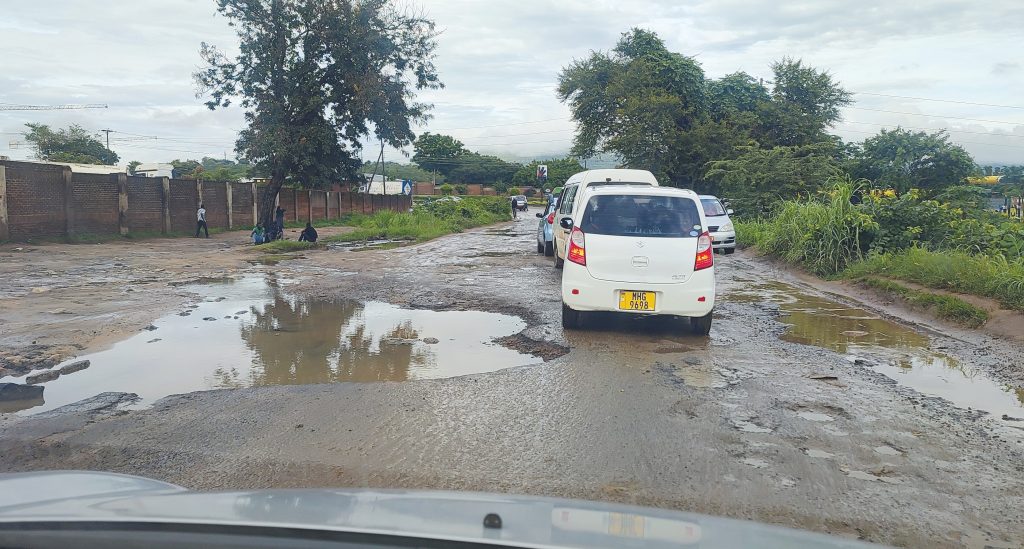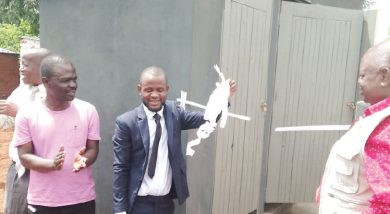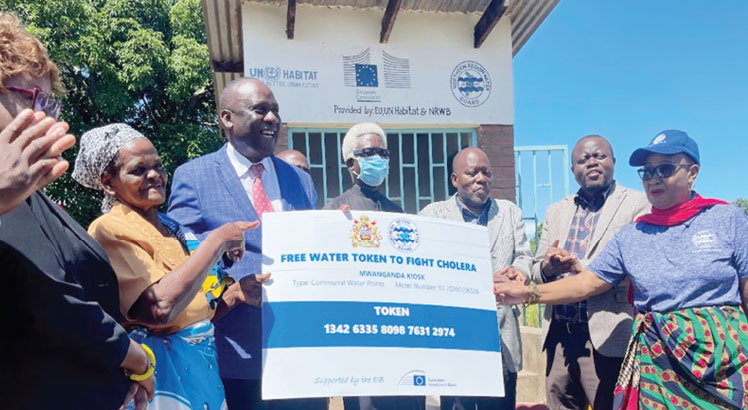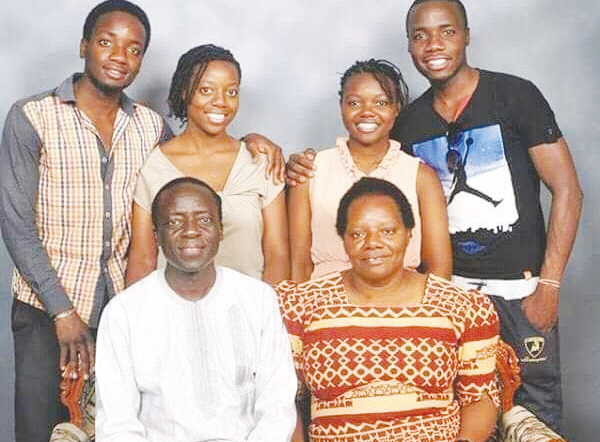Machinjiri road woes typify Malawi anguish
The roads in Machinjiri are in a bad state. Not only that. Blantyre City roads are tattered. Even the roads in Mzimba Solola, Minister of Transport and Public Works Jacob Hara’s constituency, need attention. KONDWANI KAMIYALA writes:
The cardinal rule for motorists in Malawi is to drive on the left side of the road but common sense in some sections in Machinjiri is to drive on what is left of the road, especially the main road Nkolokoti Parkway.

The road, which runs from Peletiya, where it branches from the Tsiranana Road in Limbe to Energem Filling Station at Chirimba Industrial Site where it joins the Magalasi Road, is one of the most tattered roads in Blantyre City.
The road makes residents of the township feel neglected.
Said one of them, Hastings Samangaya: “You can’t say there are potholes, for instance, at Energem, it is just one big hole with patches of tarmac here and there. It’s like the authorities are fast asleep. A road without a proper drainage system is recipe to what we are experiencing. Imagine during emergencies!”
At 5 Moba, a stage named after a hitherto popular radio programme on Malawi Broadcasting Corporation, a resident Sam Kamponda observed: “The potholes are so intense that danger-warning signs should be erected for drivers to be wary of the craters.”
When Cyclone Freddy struck in March last year, the road to Mthawira Parish was completely barred. President Lazarus Chakwera, who wanted to visit survivors at the parish camp, cancelled the visit due to the bad road.
Spouse to the Vice-President Mary Chilima had to walk for half a kilometre to the parish as the road was impassable. And when former Minister of Information Gospel Kazako went to donate two cows to the victims as a Machinjiri resident, his Toyota Land Cruiser stuck in the mud and he had to walk the rest of the way.
The then parish priest Father Elezio Ntharika said the feeder road to the parish was in very bad shape. “When the President wanted to visit the survivors, someone wanted to apply malasha, but he changed his mind when the President cancelled his visit.”
In separate random interviews, six residents felt they are not regarded as residents of the commercial capital.
Chayamba Nkhungudzu, who has lived in the township for 13 years, said the residents have not only been forgotten, but are also forsaken.
“The roads are archaic. Things keep worsening, especially during the rainy season as there is absolutely no drainage. Are we really part of Blantyre City?” he wondered.
Nkhungudzu said it is a wonder that although the dusty road that connects the Nkolokoti Parkway to the Zomba Road through the township’s Area 10 has been earmarked for rehabilitation in three national budgets, it remains a dusty road that is always flooded during the rainy season.
Videos of a section of the road go viral each rainy season, where cars are stuck in a ‘river’ that forms on the road. While the 4.2-kilometre Old Zomba Road stretch remains dusty and muddy, the Ministry of Finance 2023/24 financial statement indicates that K1 380 000 000 was approved for the upgrading of the road to asphalt surface in the 2022/23 Budget. This was revised to K810 798 630 and in the current budget, K1 380 000 000 has been estimated for the road.
Ironically, there are tangible works to construct or upgrade other roads listed in that vote for the Blantyre City Council (BCC) such as the Ndirande-Nkolokoti via Makheta, Mahatma Gandhi-Kapeni, Michiru-Likhubula, Newlands-Manje via Chiwembe, Namiwawa-Sunnyside and the Lali Lubani-Chinyonga.
“We have engaged city authorities as to why there have been no works on this road, although it appears in each budget. In their books, this is a tarmac road. At times, as residents, we have had to contribute money and other resources to make the roads passable, yet we pay taxes. It is not working,” said Nkhungudzu.
Civil action bore fruits, once
In January last year, the Nkolokoti Parkway was cut off as rain water swept off Makalanga Bridge. This led residents to spend more as minibus fares rose from K700 to K1 500 to go to and from Limbe as they had to change minibuses on the two sides of the bridge. Those with cars heading to Limbe had to drive through the Magalasi and Makata roads into the Kamuzu Highway to Limbe.
Asabuni Phiri, leader of the Machinjiri First initiative, recalls that the hardships that came with the cut-off forced residents to take to the streets and petition the BCC. This paid off as two days after the demonstrations in February, the council found a contractor to rehabilitate the bridge, at the tune of K902 million.
The bridge was opened by Blantyre City East Member of Parliament John Bande and Blantyre Mayor Wild Ndipo in November last year.
“Why are we forgotten like this? We have no council market, nor do we have a day secondary school. Bright children are selected to faraway schools like Chichiri, Ndirande Hill and Zingwangwa. We only have community day secondary schools. Our children are suffering and parents have to dig deeper into their pockets for transport fares.
“On the road, which needs a complete overhaul, should we go back to the streets and demand for these services as taxpayers? We may have to go back to the streets like we did with Makalanga,” said Phiri.
He agreed with Nkhungudzu that they have been engaging BCC on the state of the roads, wondering why other townships have enjoyed road upgrades and new constructions. Chakwera recently toured some of the roads with completed works and those in progress.
According to the Information Platform for Public Infrastructure (IPPI Malawi), a virtual construction sector transparency initiative which allows government departments, international parties and local government councils to upload on-going and finished public works, the maintenance of box culverts at the Makalanga Bridge is the only emergency work listed under the BCC. The portal is run by the Malawi Government, the Integrity Platform and the National Construction Industry Council with funding from the European Union.
African Institute of Corporate Citizenship (AICC) governance programmes manager Jeff Kabondo said residents of Machinjiri can use the IPPI as evidence for advocacy actions and hold duty bearers accountable where infrastructure like roads are concerned.
“The data can be used for engaging councils and lobbying them to act against inequalities like these. Public works have to be monitored and there must be transparency in the way resources are allocated,” he said.
Officials agree, disagree
BCC spokesperson Deborah Luka said funding is ready for the rehabilitation of the Nkolokoti Parkway, from the Energem Filling Station to Area 5 in Machinjiri. According to her, there are two separate funding for the road from the World Bank under the Regional Climate Resilience Programme (RCRP) and the Malawi Resilience and Disaster Risk Management Project (MRDRMP)
“With a K1.2 billion funding, the MRDRMP will focus on drainage works on some critical areas of the road. The handovers for the project were done. The RCRP will see the rehabilitation of the entire road from Energem Roundabout to Area 5. The project is now in the final planning phase and will be executed very soon,” said Luka.
She, however, said there was no budgetary allocation for the upgrading of the Old Zomba Road.
But Member of Parliament for Blantyre Kabula Gertrude Nankhumwa while agreeing on the two World Bank funded projects differs on the Old Zomba Road works. She concedes with our findings and Nkhungudzu’s assertions on the budgetary allocations for the road.
She said: “Allocations have been there in the budget, but you never know how it all ends.”
The Parliamentarian said with the World Bank funding, drainage works will start soon, as it was handed over to the contractor in December. According to her, they are going by directions from the donor to start with drainage works before the road rehabilitation.
“I must concede mine is one of the biggest constituencies in the city. There are three wards as of now. It runs from Mbayani through Che Mussa towards Chileka and Lunzu. It also branches from Energem to Area 6. It is difficult to please everyone,” she said.
Imagine, each constituency got K12 million
Nankhumwa said the crucial road can only be rehabilitated with funds from the city council, not the Constituency Development Fund (CDF). She said the K100 million allocated for the CDF is not enough, as there are other obligations like paying fees for needy students as well as running revolving funds.
She added: “When Cyclone Freddy struck, the M1 was cut off at the Likhubula Bridge, which is in the constituency. That was rehabilitated by the Roads Authority since even the council had no part in it. In the same way, we can’t use CDF for the section in question.”
Machinjiri residents not alone
In April 2021, Manja residents wrote BCC through their grouping Manja Rise Up for the repair of the road. When Vice-President Saulos Chilima was scheduled to visit the area, city officials sent graders and caterpillars to make the road passable. Chilima expressed dismay at the state of the road as he was touring other infrastructures in the city.
Although the council’s director of town planning Costly Chanza assured the Veep that the road rehabilitation would start soon, the residents are still putting resources together to repair the roads.
The story resonates with residents of Manyowe Township. It is a story that people in Lilongwe’s Area 49, Senti and other townships are familiar with.
Recently, Lilongwe City Mayor Councillor Richard Banda and Lilongwe City Centre MP Alfred Jiya launched a K1.7 billion rehabilitation of the Area 18-Senti Road, barely five years after its upgrading.
Even roads in district councils have not been spared.
Patrick Mwale, executive director of the Mzimba-based Community Initiative in Development Activities (Coida), says in their engagements with stakeholders, they found gross abuse of local as well as constituency development funds.
“It is unfortunate that CDF and LDF funds are being used for some politicians’ personal gains like buying coffins or establishing revolving funds. We found that the Mzimba Stadium developed cracks while it was still under construction. Sub-standard works were evident at Mbalachanda Police Unit and Khonsolo health facility. It is not only roads that are suffering,” says Mwale.
According to him, among the sub-standard works is the bridge over Kavukula River in Mzimba Solora constituency, whose member of Parliament is Minister of Transport and Public Works, Jacob Hara. Mwale claims the bridge is impassable for cars as it was meant to be.
Says Mwale: “We engage communities that they must take duty bearers to task. They should not be satisfied when parliamentarians give them coffins and handouts at the expense of development.”
Recently, Hara lard the blame on funds for roads on non-collection of fuel levies and that Malawi has only two tollgates for collection of revenue for road reconstruction. In a press release on Tuesday last week, Consumers Association of Malawi executive director John Kapito bemoaned the state of the roads in the country, saying Malawians were being given a raw deal.





